Table of Contents
Introduction:
Historical Tours in Indonesia tapestry is woven with threads of ancient civilizations, colonial legacies, and vibrant cultural traditions. Exploring the historical sites of Indonesia offers a journey through time, unveiling tales of empires, religions, trade, and the resilience of diverse communities. From majestic temples to colonial remnants, each site narrates a chapter of Indonesia’s rich heritage.
This guide delves into the historical tours available in Indonesia, highlighting iconic landmarks, hidden gems, and the significance of these sites in understanding the country’s past. Whether you’re drawn to ancient architecture, archaeological wonders, or the stories behind each stone, Indonesia’s historical tours promise a captivating and enlightening experience for every traveler.
Brief Overview of Indonesia’s Historical Significance:
Indonesia stands as a testament to a diverse and complex history that spans millennia. From ancient kingdoms like Srivijaya and Majapahit to the colonial rule of the Dutch and Japanese occupation during World War II, Indonesia has witnessed a tapestry of cultures, traditions, and influences that have shaped its identity. The archipelago’s strategic location made it a crucial hub for trade, leading to interactions with Indian, Chinese, Arab, and European civilizations.
Importance of Historical Tours in Indonesia:
Historical tours play a pivotal role in unraveling Indonesia’s heritage by offering immersive experiences into its past. These tours provide a tangible connection to historical events, architectural marvels, cultural practices, and the lives of people who shaped Indonesia’s narrative. They foster a deeper appreciation for the country’s diverse heritage, promoting cultural preservation, education, and intercultural understanding. Through historical tours, visitors can gain insights into Indonesia’s complex history, from its ancient roots to its modern-day identity.
Borobudur Temple
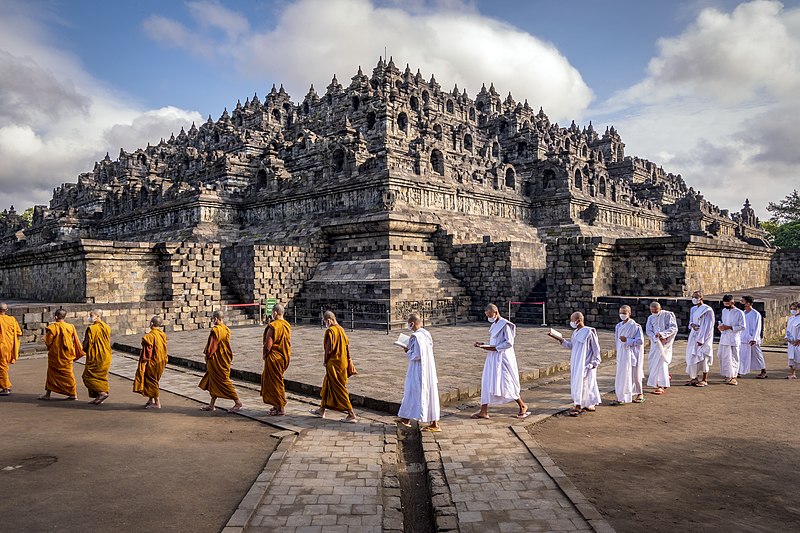
Borobudur Temple, situated in Central Java, Indonesia, stands as one of the most iconic and significant historical sites in the country. This ancient Buddhist temple dates back to the 9th century and is renowned as the world’s largest Buddhist temple complex.
Constructed during the Sailendra dynasty’s rule, Borobudur is a masterpiece of Indonesian architecture and a UNESCO World Heritage Site. The temple’s design reflects a mandala, symbolizing the Buddhist cosmology of Mount Meru, the center of the universe.
The temple’s structure comprises nine stacked platforms, with a central dome at the top adorned with 72 Buddha statues. Intricate relief panels cover the walls and balustrades, depicting scenes from Buddhist teachings, Javanese life, and historical events.
Visiting Borobudur offers a profound spiritual and cultural experience. As visitors ascend through the levels, they symbolically journey towards enlightenment, following the path of Buddhist teachings depicted in the temple’s art. The panoramic views from the top of Borobudur provide a breathtaking panorama of the surrounding lush landscapes and distant volcanoes.
Guided historical tours of Borobudur Temple delve into its architectural significance, religious symbolism, and the historical context of Buddhism in Indonesia. Visitors can also explore nearby museums and archaeological sites to gain a comprehensive understanding of Borobudur’s cultural heritage and its place in Indonesian history.
Location and Background:
Borobudur Temple is located in Central Java, Indonesia, near the town of Magelang, approximately 40 kilometers northwest of Yogyakarta. It sits amidst the lush Kedu Plain, surrounded by volcanic mountains such as Mount Merapi, Mount Merbabu, and Mount Sumbing.
The temple’s construction began during the reign of the Sailendra dynasty in the 8th century but was not completed until the 9th century under the rule of the Syailendra dynasty. It stands as a symbol of Mahayana Buddhism’s influence in Java during that era, showcasing the fusion of Indonesian indigenous beliefs with Buddhist teachings.
Architectural Features and Significance:
Borobudur’s architectural grandeur is a testament to ancient Javanese craftsmanship and spiritual devotion. The temple complex spans an area of approximately 2,500 square meters and consists of three tiers: a pyramidal base with five square terraces, followed by three circular platforms, and topped with a monumental stupa.
The entire structure is adorned with intricately carved relief panels and 504 Buddha statues. The reliefs narrate the story of Buddha’s life and teachings, representing a visual encyclopedia of Buddhist cosmology, ethics, and philosophy. The temple’s layout reflects the Buddhist concept of the path to enlightenment, with pilgrims ascending through the levels symbolizing spiritual ascent.
The significance of Borobudur extends beyond its religious and artistic value. It serves as a symbol of Indonesia’s cultural heritage and has become a national icon, attracting visitors from around the world to marvel at its beauty and historical significance.
Visitor Experience and Tours Available:
Visiting Borobudur offers a profound cultural and spiritual experience. Visitors can explore the temple complex, admiring the intricate carvings, meditating at the stupas, and soaking in the serene ambiance surrounded by lush greenery.
Guided tours are available, led by knowledgeable local guides who provide insights into Borobudur’s history, architecture, and spiritual symbolism. Sunrise and sunset tours are particularly popular, offering breathtaking views and a magical atmosphere as the temple is bathed in golden light.
In addition to exploring Borobudur, visitors can also visit nearby attractions such as Pawon Temple, Mendut Temple, and the Borobudur Archaeological Museum to enhance their understanding of Javanese history and culture. Overall, the visitor experience at Borobudur Temple is immersive, educational, and spiritually enriching, making it a must-visit destination for anyone exploring Indonesia’s historical treasures.
Prambanan Temple
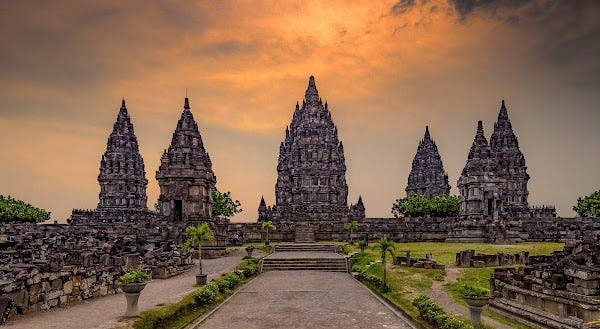
Prambanan Temple, located in Central Java, Indonesia, is a masterpiece of Hindu architecture and one of the most significant historical sites in the region. Constructed in the 9th century during the rule of the Mataram Kingdom, Prambanan is dedicated to the Trimurti, the three main Hindu deities: Brahma the creator, Vishnu the preserver, and Shiva the destroyer. The temple complex consists of several towering structures, with the central compound housing the impressive Shiva temple, rising to a height of over 47 meters. Surrounding temples are dedicated to Vishnu, Brahma, and other Hindu gods and goddesses, adorned with intricate carvings depicting mythological scenes and celestial beings. Prambanan’s architectural significance lies in its intricate stone carvings, towering spires, and the spiritual symbolism embedded in every detail, showcasing the rich cultural heritage and religious devotion of ancient Java. Today, Prambanan Temple is a UNESCO World Heritage Site and a testament to Indonesia’s vibrant Hindu legacy.
Location and Historical Context:
Prambanan Temple is situated in Central Java, Indonesia, approximately 17 kilometers northeast of Yogyakarta. It stands as a testament to Indonesia’s rich historical and cultural heritage, dating back to the 9th century when it was built during the height of the Mataram Kingdom’s rule. The temple complex was dedicated to Hindu gods and served as a center for religious and cultural activities, reflecting the region’s strong Hindu-Buddhist influence during that era.
Hindu Influence and Cultural Significance:
Prambanan Temple’s significance lies in its representation of Hindu cosmology and mythology. The temple complex is dedicated to the Trimurti, with three main temples symbolizing Brahma, Vishnu, and Shiva—the Hindu trinity responsible for creation, preservation, and destruction, respectively. The intricate stone carvings and reliefs depict scenes from Hindu epics such as the Ramayana and Mahabharata, showcasing the artistic prowess and religious devotion of ancient Javanese craftsmen.
The temple’s cultural significance extends beyond its religious symbolism. It serves as a reminder of Indonesia’s historical connections with Hindu kingdoms and the enduring legacy of Hinduism in shaping the region’s art, architecture, and spiritual beliefs. Prambanan Temple’s inclusion on the UNESCO World Heritage List highlights its global recognition and importance as a cultural treasure.
Tourist Attractions and Exploration Options:
Visitors to Prambanan Temple can explore not only the main Trimurti temples but also numerous smaller shrines, pavilions, and gateways within the complex. The central courtyard hosts regular performances of the Ramayana ballet, a traditional Javanese dance-drama that brings Hindu epics to life through music, dance, and elaborate costumes.
Nearby attractions include the Ratu Boko archaeological site, which offers panoramic views of Prambanan Temple and insights into ancient Javanese royal palaces. Additionally, travelers can visit the Prambanan Archaeological Museum to learn more about the temple’s history, architecture, and archaeological discoveries.
For a more immersive experience, guided tours led by knowledgeable local guides provide in-depth information about Prambanan’s cultural and religious significance. Sunrise and sunset visits offer stunning views and a tranquil ambiance, allowing visitors to appreciate the temple’s beauty amidst the natural surroundings. Overall, Prambanan Temple offers a captivating journey into Indonesia’s past and a glimpse into the enduring legacy of Hindu civilization in the region.
Yogyakarta
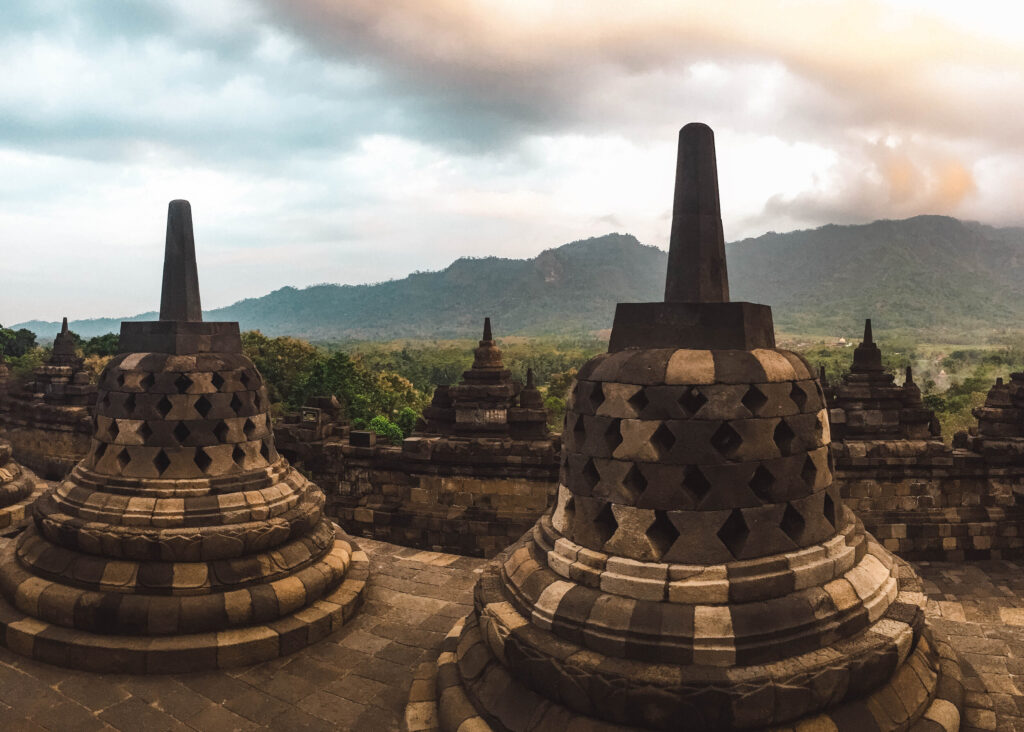
Yogyakarta, often referred to as Jogja, is a cultural and historical gem nestled in Central Java, Indonesia. This city is renowned for its rich heritage, traditional arts, and Javanese royal legacy. As the only Indonesian royal city still ruled by a monarchy, Yogyakarta exudes a regal charm, with the Kraton (Sultan’s Palace) serving as its cultural heart. The Kraton is a living museum showcasing Javanese architecture, court traditions, and a vast collection of royal artifacts.
Aside from its royal heritage, Yogyakarta is a hub of artistic expression, with vibrant batik workshops, traditional gamelan music performances, and shadow puppetry (wayang kulit) shows enchanting visitors with their beauty and cultural significance. The city’s cultural richness is further exemplified by its numerous art galleries, museums, and cultural centers, such as the Sonobudoyo Museum and Benteng Vredeburg Museum.
Yogyakarta also boasts natural wonders, including the majestic Mount Merapi volcano and the scenic Parangtritis Beach. Travelers can embark on adventures like hiking to the summit of Mount Merapi or exploring ancient temples like Prambanan and Borobudur, both UNESCO World Heritage Sites.
The city’s bustling markets, culinary delights, and warm hospitality add to its allure, making Yogyakarta a must-visit destination for those seeking a blend of history, culture, and natural beauty in Indonesia.
Historical Importance as a Cultural Hub:
Yogyakarta holds immense historical importance as a cultural hub in Indonesia. It was once the seat of power for the Mataram Sultanate and later became a center of Javanese arts, literature, and education. The city’s strategic location facilitated trade and cultural exchanges, attracting scholars, artists, and traders from across the archipelago and beyond. This rich cultural heritage continues to thrive, making Yogyakarta a vibrant melting pot of traditions, languages, and artistic expressions.
Sultan’s Palace (Kraton) and its Historical Significance:
The Sultan’s Palace, locally known as Kraton Ngayogyakarta Hadiningrat, stands as an iconic symbol of Yogyakarta’s royal legacy and historical significance. Built in the 18th century, the Kraton is the official residence of the Sultan of Yogyakarta and a living testament to Javanese court culture. Visitors can explore the palace’s intricate architecture, royal artifacts, and traditional ceremonies, gaining insights into the city’s royal heritage and the role of the Sultan in contemporary Indonesia.
Other Historical Sites and Museums in Yogyakarta:
Yogyakarta is home to numerous historical sites and museums that offer glimpses into its past and cultural diversity. The Taman Sari Water Castle, once a royal garden and bathing complex, showcases the ingenuity of Javanese architecture and hydraulic engineering. The Benteng Vredeburg Museum provides a fascinating journey through Indonesia’s struggle for independence, with exhibitions on colonial history and the nation’s path to sovereignty.
Other notable sites include the Kotagede neighborhood, known for its ancient mosques, traditional silver craftsmanship, and historical landmarks dating back to the Mataram Kingdom. Additionally, the Affandi Museum honors the legacy of one of Indonesia’s renowned painters, showcasing his artworks and contributions to modern Indonesian art.
Yogyakarta’s cultural richness extends to its performing arts scene, with regular Wayang Kulit (shadow puppetry) performances, traditional Javanese dance shows, and gamelan music ensembles captivating audiences with their beauty and cultural significance.
Overall, Yogyakarta’s historical sites and museums offer a captivating journey through Indonesia’s past, highlighting the city’s role as a custodian of Javanese heritage and a vibrant center of cultural exchange and creativity.
Jakarta Old Town (Kota Tua)
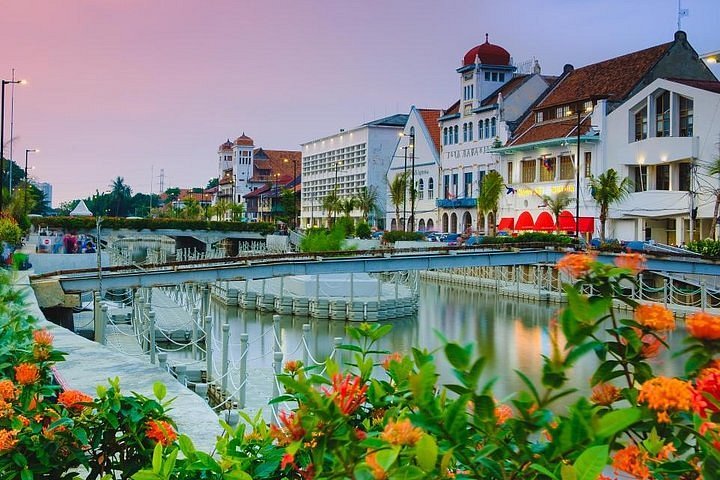
Jakarta Old Town, commonly known as Kota Tua, is a captivating historical district located in the heart of Indonesia’s bustling capital city. This area serves as a living testament to Jakarta’s colonial past, showcasing well-preserved Dutch colonial architecture, charming cobblestone streets, and a rich cultural heritage.
Kota Tua’s historical importance dates back to the 17th century when it served as the center of Dutch colonial administration in the East Indies. The area flourished as a trading hub, attracting merchants, craftsmen, and settlers from various parts of the world. Today, it stands as a cultural and historical gem, inviting visitors to immerse themselves in Jakarta’s diverse heritage.
One of the key attractions in Kota Tua is the Jakarta History Museum, also known as the Fatahillah Museum, housed in a former Dutch colonial building. The museum showcases artifacts, paintings, and exhibits that narrate Jakarta’s evolution from a small port town to a bustling metropolis. Visitors can explore the museum’s galleries, learning about the city’s maritime history, colonial era, and cultural transformations.
Walking through Kota Tua, visitors encounter iconic landmarks such as the Fatahillah Square, dominated by the imposing Jakarta History Museum and surrounded by quaint cafes and street vendors offering local delicacies. The area’s architectural charm is evident in buildings like the Old City Hall (Gedung Kesenian Jakarta) and the Bank Indonesia Museum, both architectural gems that reflect Jakarta’s architectural diversity.
Art enthusiasts will appreciate Kota Tua’s vibrant art scene, with galleries showcasing contemporary and traditional Indonesian art. The area also hosts cultural events, performances, and street art exhibitions, adding to its dynamic atmosphere.
Exploring Kota Tua is like stepping back in time, where every corner tells a story of Jakarta’s past. From leisurely strolls along its historic streets to indulging in local cuisine and admiring colonial-era buildings, Kota Tua offers a delightful blend of history, culture, and artistic expression that makes it a must-visit destination for travelers exploring Jakarta’s diverse heritage.
Colonial-era District Overview:
Kota Tua, also known as Jakarta Old Town, is a captivating colonial-era district nestled in the heart of Indonesia’s bustling capital, Jakarta. This historic area dates back to the 17th century when it served as the center of Dutch colonial administration in the East Indies. Today, it stands as a cultural treasure trove, with well-preserved colonial architecture, charming cobblestone streets, and a rich heritage that reflects Jakarta’s evolution from a trading port to a vibrant metropolis.
Key Historical Buildings and Landmarks:
- Jakarta History Museum (Fatahillah Museum): Housed in a former Dutch colonial building, this museum showcases artifacts, paintings, and exhibits that narrate Jakarta’s history, from its early days as a port town to its colonial period and beyond.
- Old City Hall (Gedung Kesenian Jakarta): This iconic building serves as a reminder of Jakarta’s colonial past, featuring beautiful architecture and historical significance.
- Bank Indonesia Museum: Located in the historical Bank Indonesia building, this museum offers insights into Indonesia’s monetary history, with displays of currency, artifacts, and interactive exhibits.
- Kota Intan Bridge (Kali Besar Bridge): A picturesque bridge spanning the Kali Besar canal, offering scenic views of the historic waterfront and colonial-era buildings.
- Wayang Museum: Dedicated to Javanese wayang (shadow puppetry), this museum houses a vast collection of wayang kulit (leather puppets) and other traditional puppetry artifacts, providing a glimpse into Indonesia’s cultural heritage.
Museums and Attractions for History Enthusiasts:
- Museum Bank Mandiri: Housed in a historic bank building, this museum showcases Indonesia’s banking history, with exhibits on currency, banking practices, and economic development.
- Fine Arts and Ceramics Museum: Featuring a collection of Indonesian fine arts, ceramics, and pottery, this museum offers a cultural journey through Indonesia’s artistic heritage.
- Maritime Museum: Located near the waterfront, this museum explores Indonesia’s maritime history, with exhibits on traditional boats, seafaring traditions, and maritime trade.
- Wayang Orang Bharata Theater: A cultural center for wayang orang (traditional Javanese dance-drama), offering performances and workshops on this ancient art form.
- Taman Fatahillah Square: A vibrant public square surrounded by historical buildings, cafes, and street vendors, ideal for leisurely walks and soaking in the atmosphere of Kota Tua.
Overall, Kota Tua is a treasure trove for history enthusiasts, offering a blend of colonial-era charm, cultural attractions, and museums that provide insights into Jakarta’s rich and diverse heritage.
Banda Islands
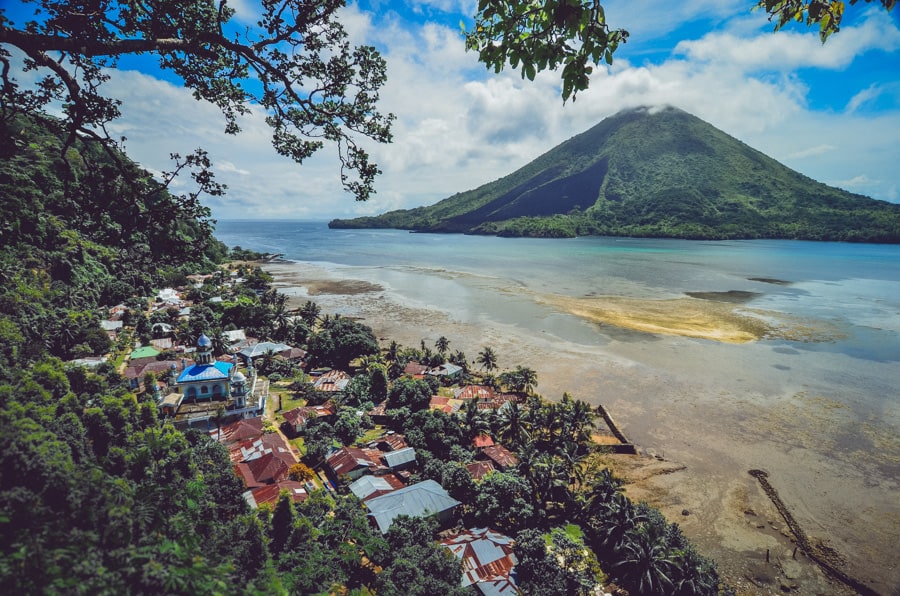
The Banda Islands, situated in the Maluku province of Indonesia, are a hidden gem with a fascinating historical significance. These remote islands were once the world’s only source of nutmeg, making them highly sought-after by colonial powers during the spice trade era in the 16th and 17th centuries. The allure of the Banda Islands lies not only in their natural beauty—lush forests, crystal-clear waters, and coral reefs—but also in their rich historical heritage.
During the colonial period, the Banda Islands were fiercely contested by European powers such as the Dutch, British, and Portuguese due to the lucrative nutmeg trade. The remnants of this colonial past can still be seen today in the form of fortresses, old plantations, and historical buildings scattered across the islands.
One of the key attractions on the Banda Islands is Fort Belgica, a Dutch fortress built in the 17th century to protect the nutmeg trade. The fort offers panoramic views of the surrounding islands and provides insights into the region’s tumultuous history. Visitors can explore the fort’s ramparts, cannons, and underground tunnels while learning about the colonial conflicts that shaped the Banda Islands.
Aside from Fort Belgica, the Banda Islands offer opportunities for cultural immersion and outdoor activities. Travelers can visit the local villages to experience traditional Bandaese culture, sample local cuisine, and interact with friendly locals. Snorkeling and diving enthusiasts will be delighted by the underwater wonders of the Banda Islands, including vibrant coral reefs, diverse marine life, and historic shipwrecks.
The Banda Islands also boast natural attractions such as Gunung Api, an active volcano with breathtaking views from its summit. Hiking to the volcano’s crater is a popular activity for adventurous travelers seeking an unforgettable experience.
In addition to its historical and natural attractions, the Banda Islands offer a peaceful and tranquil escape from the bustling cities, allowing visitors to unwind amidst stunning landscapes and rich cultural heritage. Whether exploring historical sites, diving into crystal-clear waters, or simply enjoying the island life, the Banda Islands promise a memorable and immersive travel experience.
Colonial History and Significance of Banda Islands:
The Banda Islands hold a significant place in colonial history, particularly during the spice trade era in the 16th and 17th centuries. These remote islands, located in the Maluku province of Indonesia, were once the epicenter of the global nutmeg trade. The nutmeg, along with cloves, was highly prized for its culinary and medicinal properties, leading to intense competition among colonial powers, including the Dutch, Portuguese, English, and Spanish.
The Dutch East India Company (VOC) gained control over the Banda Islands, making them the world’s only source of nutmeg. The islands’ strategic importance and economic value fueled colonial conflicts, with the Dutch fortifying their presence through forts, plantations, and trade monopolies.
The colonial history of the Banda Islands is a testament to the impact of the spice trade on global commerce, cultural exchange, and geopolitical dynamics during the Age of Exploration.
Nutmeg Trade and Colonial Heritage Sites:
The nutmeg trade was the lifeblood of the Banda Islands during the colonial era, shaping their economy, culture, and landscape. Today, remnants of this rich heritage can be seen in the form of colonial-era forts, plantations, and historical buildings scattered across the islands.
Fort Belgica, built by the Dutch in the 17th century, stands as a prominent colonial heritage site on the Banda Islands. This fortress, overlooking the sea, served as a strategic stronghold for the Dutch East India Company and played a crucial role in protecting the nutmeg trade from rival powers.
The remnants of old nutmeg plantations, once bustling with activity, offer glimpses into the island’s agrarian past and the labor-intensive process of nutmeg cultivation. Colonial-era buildings, such as old warehouses and Dutch-style houses, add to the historical charm of the Banda Islands, providing insights into the island’s colonial legacy.
Tourist Activities and Historical Exploration Options:
Visitors to the Banda Islands can immerse themselves in a range of tourist activities that blend natural beauty with historical exploration. Snorkeling and diving enthusiasts can explore vibrant coral reefs, underwater gardens, and marine life in the crystal-clear waters surrounding the islands.
Historical exploration options abound, with guided tours of Fort Belgica, nutmeg plantations, and other colonial heritage sites. Travelers can delve into the island’s history, learn about the nutmeg trade, and admire colonial architecture while soaking in panoramic views of the tropical landscape.
Cultural experiences include visits to local villages, where travelers can interact with friendly locals, sample traditional cuisine, and discover Bandaese customs and traditions. Hiking enthusiasts can trek to the summit of Gunung Api, an active volcano, for breathtaking views and a sense of adventure.
Overall, the Banda Islands offer a unique blend of historical heritage, natural wonders, and cultural immersion, making them a captivating destination for travelers interested in exploring Indonesia’s colonial past and spice trade legacy.
Trowulan
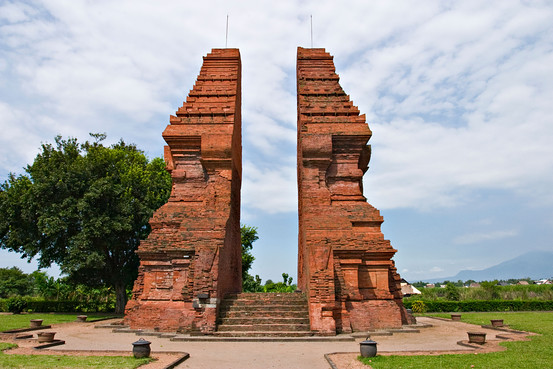
Trowulan, located in East Java, Indonesia, holds immense historical significance as the former capital of the mighty Majapahit Empire. This ancient archaeological site is a treasure trove of ruins, temples, and artifacts that offer insights into one of Southeast Asia’s most powerful and influential kingdoms.
During its zenith in the 14th century, the Majapahit Empire ruled over vast territories encompassing modern-day Indonesia, Malaysia, Singapore, and parts of the Philippines. Trowulan served as the empire’s political and cultural center, showcasing the grandeur and sophistication of Javanese civilization.
Visitors to Trowulan can explore a wealth of historical sites and archaeological remains that reflect the empire’s glory. The Bajang Ratu Gate, a majestic stone gateway, stands as an iconic symbol of Majapahit architecture and marks the entrance to Trowulan’s archaeological park. Nearby, the Candi Tikus (Rat Temple) offers a glimpse into ancient Javanese religious practices, with its well-preserved bathing pools and temple ruins.
The Trowulan Museum, located within the archaeological park, houses a vast collection of artifacts, sculptures, and inscriptions from the Majapahit era. Visitors can marvel at ancient ceramics, weaponry, religious relics, and artworks that provide a window into the empire’s cultural heritage and artistic achievements.
Another highlight of Trowulan is the site of the Majapahit Palace complex, believed to have been the residence of the empire’s rulers. Although mostly in ruins, the palace area offers an atmospheric setting for historical exploration, with remnants of walls, gates, and ceremonial structures.
Exploring Trowulan offers a fascinating journey through Indonesia’s past, unraveling the legacy of the Majapahit Empire and its contributions to Southeast Asian history. The site’s archaeological significance, coupled with its cultural and historical richness, makes it a must-visit destination for travelers interested in ancient civilizations and archaeological wonders.
Overview of Trowulan as the “City of Majapahit”:
Trowulan holds the esteemed title of being the “City of Majapahit,” a designation that reflects its historical importance as the capital of the illustrious Majapahit Empire. This ancient city, located in East Java, Indonesia, served as the epicenter of Javanese civilization during the empire’s peak in the 14th century. Trowulan’s significance lies in its role as the political, cultural, and economic hub of one of Southeast Asia’s most formidable and influential kingdoms.
Archaeological Sites and Ruins from the Majapahit Empire:
Trowulan is home to a plethora of archaeological sites and ruins that provide tangible glimpses into the grandeur and sophistication of the Majapahit Empire. One of the most iconic sites is the Candi Tikus (Rat Temple), an ancient bathing complex adorned with intricate stone carvings and sculptures. This site offers insights into the empire’s religious practices and architectural achievements.
The Bajang Ratu Gate, an imposing stone gateway, marks the entrance to Trowulan’s archaeological park and stands as a testament to Majapahit’s architectural prowess. Visitors can also explore the remnants of the Majapahit Palace complex, including walls, gates, and ceremonial structures, providing a sense of the empire’s royal grandeur.
Additionally, Trowulan boasts numerous archaeological excavations that have unearthed artifacts, pottery, inscriptions, and relics from the Majapahit era. These discoveries contribute to a deeper understanding of the empire’s history, culture, and societal structures.
Cultural Insights and Historical Significance of Trowulan:
Trowulan offers profound cultural insights and holds immense historical significance as a window into Indonesia’s past. The archaeological sites and ruins not only showcase the empire’s material legacy but also provide insights into its political organization, trade networks, religious beliefs, and artistic achievements.
Visitors to Trowulan can gain a deeper appreciation for Javanese civilization, exploring the remnants of a once-mighty empire and uncovering the intricate details of daily life, governance, and cultural practices during the Majapahit era. The site’s historical significance extends beyond its archaeological value, serving as a source of national pride and cultural heritage for Indonesia.
Overall, Trowulan stands as a testament to the resilience, creativity, and cultural richness of the Majapahit Empire, offering a captivating journey through Indonesia’s ancient history and leaving visitors with a profound sense of awe and admiration for this remarkable civilization.
Bali’s Cultural Sites
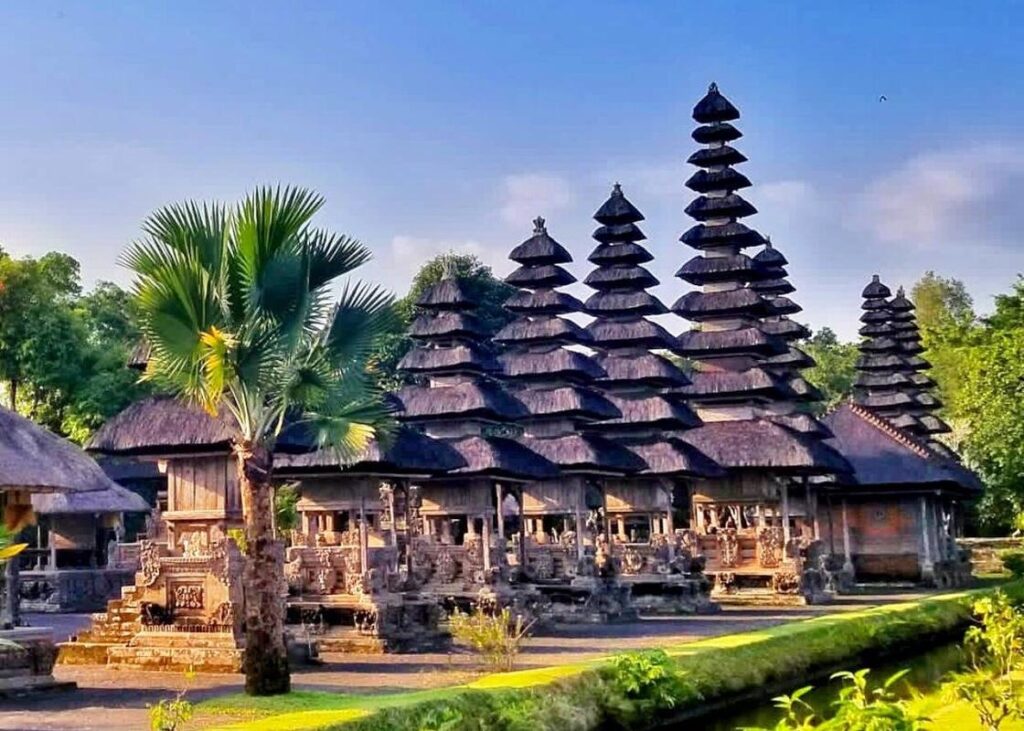
Bali, often referred to as the “Island of the Gods,” is renowned for its vibrant culture, spiritual heritage, and rich artistic traditions. The island is home to a myriad of cultural sites that offer insights into Balinese Hinduism, traditional arts, and historical legacies. Here are some of the must-visit cultural sites in Bali:
- Besakih Temple: Known as the “Mother Temple of Bali,” Besakih is the largest and holiest temple complex on the island. Perched on the slopes of Mount Agung, Bali’s highest volcano, Besakih is a sprawling complex comprising multiple temples, shrines, and pavilions. It is a center of Balinese Hindu worship and ceremonies, offering breathtaking views and a spiritual atmosphere.
- Goa Gajah (Elephant Cave): Located near Ubud, Goa Gajah is an ancient archaeological site dating back to the 9th century. The cave entrance is adorned with intricate stone carvings and a menacing creature’s face, leading to a small chamber with rock-cut lingam and yoni symbols. Goa Gajah is a blend of Hindu and Buddhist influences, showcasing Bali’s cultural diversity.
- Taman Ayun Temple: Situated in Mengwi, Taman Ayun is a royal temple complex surrounded by water features and lush gardens. The temple’s architecture reflects traditional Balinese design, with tiered meru towers, intricately carved gates, and serene courtyards. It is a UNESCO World Heritage Site and a peaceful oasis for spiritual contemplation.
- Uluwatu Temple: Perched on a cliff overlooking the Indian Ocean, Uluwatu Temple is a spectacular sea temple known for its stunning sunset views and traditional Kecak fire dance performances. The temple’s location offers panoramic vistas and a sense of serenity amidst the natural beauty of Bali’s southern coast.
- Pura Ulun Danu Bratan: Located on the shores of Lake Bratan in Bedugul, this picturesque water temple is dedicated to Dewi Danu, the goddess of water, fertility, and prosperity. The temple’s iconic pagoda-like structures and tranquil setting make it a popular spot for photography and cultural immersion.
- Tenganan Village: Tucked away in East Bali, Tenganan is one of the island’s oldest traditional villages, known for its unique cultural practices and preserved way of life. The village is famous for its double-ikat weaving technique, traditional ceremonies, and ancient architecture, providing a glimpse into Bali’s indigenous heritage.
- Ubud Palace (Puri Saren Agung): Situated in the heart of Ubud, this royal palace showcases traditional Balinese architecture, intricate carvings, and cultural performances. Visitors can witness traditional dance shows, explore the palace grounds, and admire Balinese craftsmanship.
These cultural sites in Bali offer a fascinating journey into the island’s spiritual, artistic, and historical heritage, making them essential stops for travelers seeking a deeper understanding of Balinese culture and traditions.
Overview of Bali’s Historical and Cultural Attractions:
Bali, often dubbed the “Island of the Gods,” boasts a rich tapestry of historical and cultural attractions that draw travelers from around the globe. From ancient temples and royal palaces to traditional arts and vibrant ceremonies, Bali offers a captivating blend of heritage and spirituality. The island’s unique blend of Hindu-Buddhist traditions, indigenous customs, and colonial influences create a cultural mosaic that defines its identity.
Besakih Temple and Its Significance:
Besakih Temple, also known as Pura Besakih or the “Mother Temple of Bali,” holds immense significance as the largest and most important Hindu temple complex on the island. Perched on the slopes of Mount Agung, Bali’s highest volcano, Besakih is not just a place of worship but a spiritual center revered by Balinese Hindus.
The temple complex comprises multiple shrines, courtyards, and pavilions dedicated to various Hindu deities, with the main temple dedicated to Shiva, the destroyer god. Besakih plays a crucial role in Balinese Hindu rituals, ceremonies, and religious festivals, including the iconic Galungan and Kuningan celebrations.
Visitors to Besakih can marvel at its architectural splendor, with tiered meru towers, intricately carved stone gates (candi bentar), and panoramic views of the surrounding landscape. The temple’s spiritual ambiance, coupled with its historical and cultural significance, makes it a must-visit destination for those seeking a deeper understanding of Bali’s religious heritage.
Other Historical Sites and Cultural Experiences in Bali:
- Ubud Palace (Puri Saren Agung): Located in Ubud, this royal palace showcases traditional Balinese architecture, cultural performances, and a glimpse into the island’s royal history.
- Tirta Empul Temple: Known for its sacred spring water and purification rituals, Tirta Empul offers a spiritual experience and cultural insights into Balinese Hindu practices.
- Goa Gajah (Elephant Cave): An ancient archaeological site near Ubud, Goa Gajah features a cave entrance adorned with stone carvings and a bathing pool, reflecting Hindu-Buddhist influences.
- Tanah Lot Temple: A sea temple perched on a rock formation along Bali’s western coast, Tanah Lot is famous for its stunning sunset views and cultural significance.
- Traditional Balinese Dance Performances: Witness captivating dance performances such as the Barong dance, Legong dance, and Kecak fire dance, showcasing Bali’s artistic heritage and storytelling traditions.
- Batuan Village: Known for its traditional Balinese paintings, Batuan offers art galleries, workshops, and insights into the island’s artistic legacy.
- Tenganan Village: An ancient village in East Bali known for its unique culture, double-ikat weaving, and traditional ceremonies, providing a glimpse into Bali’s indigenous heritage.
These historical sites and cultural experiences in Bali offer a multifaceted journey into the island’s past, traditions, and artistic expressions, enriching the travel experience with spiritual, historical, and cultural insights.
Aceh
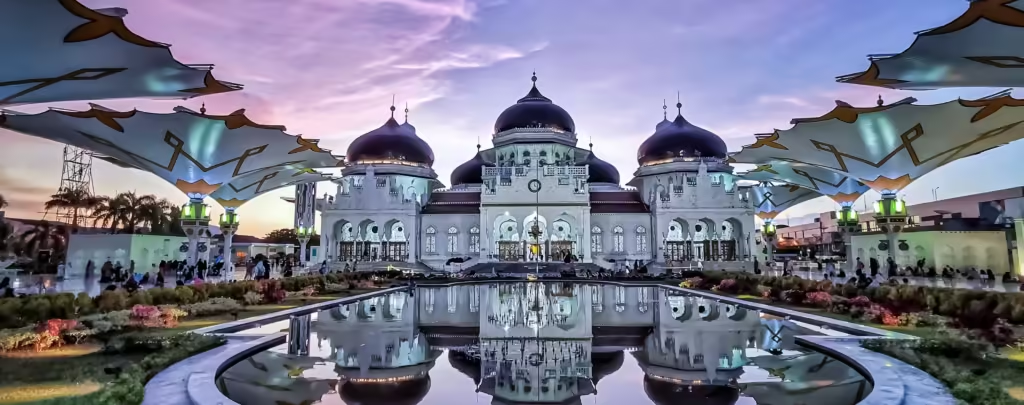
Aceh, located on the northern tip of Sumatra, Indonesia, is a region steeped in rich history, cultural diversity, and natural beauty. Known as the “Veranda of Mecca,” Aceh holds a special place in Indonesian history as one of the earliest centers of Islamic influence in Southeast Asia. The region’s historical significance is reflected in its architectural marvels, such as the Baiturrahman Grand Mosque in the capital city of Banda Aceh, which stands as a symbol of Acehnese resilience and spiritual heritage.
In addition to its cultural heritage, Aceh is blessed with stunning natural landscapes, including pristine beaches, lush rainforests, and volcanic peaks. The region’s eco-tourism attractions, such as the Leuser National Park and the iconic Weh Island, offer opportunities for adventure, wildlife spotting, and outdoor exploration. Aceh’s unique blend of cultural richness and natural wonders makes it a captivating destination for travelers seeking a deeper connection with history, culture, and nature in Indonesia.
Historical Importance of Aceh as a Center of Islamic Learning:
Aceh holds immense historical importance as a center of Islamic learning and influence in Southeast Asia. Dating back to the 13th century, Aceh became a prominent hub for Islamic scholarship, attracting scholars, traders, and travelers from across the Muslim world. The region’s strategic location along major trade routes facilitated the exchange of ideas, culture, and religious teachings, shaping Aceh into a thriving center of Islamic civilization.
One of the notable contributions of Aceh to Islamic history is the development and spread of Islamic jurisprudence (fiqh) known as the “Aceh School.” This school of thought had a significant impact on the interpretation and practice of Islamic law in the region and beyond. Aceh’s historical role as a bastion of Islamic scholarship and cultural exchange continues to be revered in the Muslim world.
Key Historical Sites and Landmarks in Aceh:
- Baiturrahman Grand Mosque: Located in Banda Aceh, the Baiturrahman Mosque is a symbol of Acehnese Islamic heritage and resilience. The mosque’s architecture reflects a blend of traditional Acehnese and Ottoman influences, with its iconic white dome and minarets dominating the city’s skyline.
- Sultan Iskandar Muda’s Tomb: The royal tomb complex in Banda Aceh is dedicated to Sultan Iskandar Muda, a revered ruler of Aceh during the 17th century. The site is a pilgrimage destination and a testament to Aceh’s royal history.
- Aceh Tsunami Museum: Commemorating the devastating 2004 Indian Ocean tsunami, this museum in Banda Aceh pays tribute to the lives lost and the resilience of the Acehnese people in the face of adversity.
- Gunongan: A historic monument in Banda Aceh, the Gunongan is believed to be a remnant of Sultan Iskandar Muda’s palace. The structure, with its unique architectural features and legends, offers insights into Aceh’s royal past.
Dutch Colonial Heritage and Cultural Insights:
Aceh’s history also encompasses a period of Dutch colonial rule, marked by conflicts and resistance against colonial expansion. The Dutch influence in Aceh is evident in colonial-era buildings, forts, and remnants of Dutch administration.
One of the notable Dutch colonial legacies in Aceh is Fort Kuto Besak, a historic fortress in Banda Aceh that dates back to the Dutch East Indies era. The fort’s strategic location and architecture reflect the colonial military presence in the region.
Culturally, Aceh’s unique blend of Islamic traditions, local customs, and indigenous beliefs shapes its identity. The region’s arts, cuisine, and performing arts, such as Saman dance, reflect a vibrant cultural heritage that has evolved over centuries of cultural exchange and resilience. Aceh’s cultural insights offer visitors a deeper understanding of the region’s complex history and diverse cultural tapestry.
Conclusion of Historical Tours in Indonesia
Exploring Indonesia’s historical tours unveils a rich tapestry of cultural heritage, ancient civilizations, and colonial legacies that continue to shape the country’s identity today. From the majestic temples of Borobudur and Prambanan to the royal palaces of Yogyakarta and the fortified forts of Aceh, each destination offers a glimpse into Indonesia’s vibrant past and diverse cultural landscape. The historical significance of these sites, whether as centers of Islamic learning, hubs of maritime trade, or showcases of ancient architecture, highlights Indonesia’s role as a cradle of civilization in Southeast Asia. Moreover, the preservation and promotion of these historical treasures through museums, guided tours, and cultural performances ensure that future generations can appreciate and learn from Indonesia’s rich history. As travelers embark on historical tours in Indonesia, they not only witness the grandeur of ancient civilizations but also gain a deeper appreciation for the country’s cultural heritage, traditions, and resilience across centuries of history. Indonesia’s historical tours serve as a bridge between the past and the present, offering immersive experiences that enrich the mind and soul, making them an indispensable part of any exploration of this diverse and fascinating archipelago.
Read more Historical Tours in Cambodia
